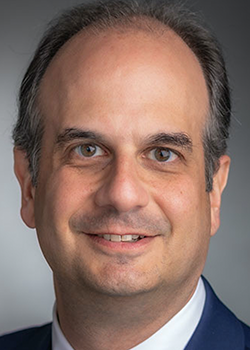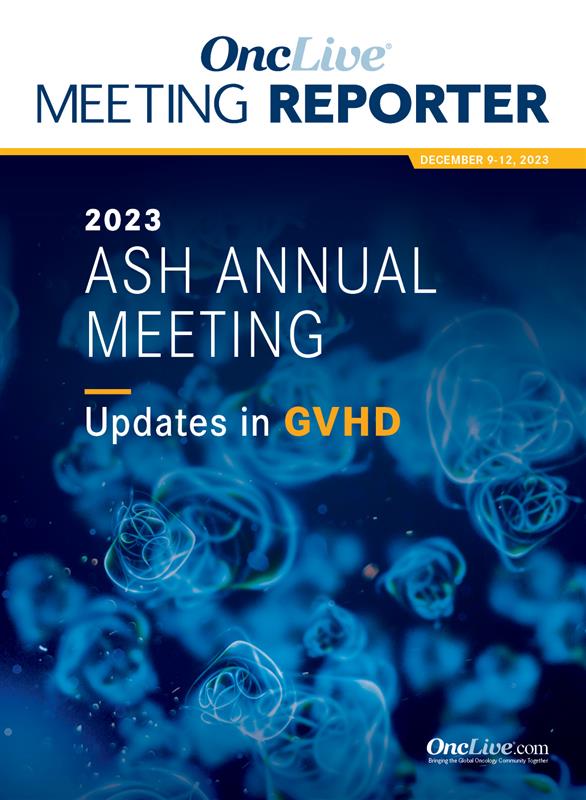News
Article
Supplements and Featured Publications
Obinutuzumab Use Decreases Incidence of Steroid-Requiring cGVHD After Transplant
Author(s):
Utilizing obinutuzumab to enhance B-cell depletion significantly reduced the need for corticosteroids and increased relapse-free survival in patients with steroid-requiring chronic graft-vs-host disease undergoing well-matched hematopoietic stem cell transplant.
Corey Cutler, MD

Utilizing obinutuzumab (Gazyva) to enhance B-cell depletion significantly reduced the need for corticosteroids and increased relapse-free survival in patients with steroid-requiring chronic graft-vs-host disease (cGVHD) undergoing well-matched hematopoietic stem cell transplant, according to results from a phase 2 study (NCT02867384) presented during the 2023 ASH Annual Meeting.
Primary findings from the study showed that the incidence of corticosteroid-requiring cGVHD significantly decreased at both 1 and 2 years with obinutuzumab compared with placebo (P = .029). One-year rates of steroid-requiring cGVHD were 12% (95% CI, 6.5%-20%) and 37% (95% CI, 27%-47%) with obinutuzumab vs placebo, respectively; 2-year rates for these respective groups were 30% (95% CI, 21%-40%) and 43% (95% CI, 32%-53%). Controlling for other established risk factors for cGVHD through multivariable analysis, such as age, gender, donor and conditioning type, and prior acute GVHD, study treatment was the sole significant risk factor for the development of steroid-requiring cGVHD (HR, 0.56; 95% CI, 0.33-0.94; P = .028). The obinutuzumab group also exhibited a lower occurrence of moderate to severe cGVHD at 1 and 2 years (P = .056), while the overall incidence of cGVHD remained unchanged (P = 0.87).
There were no significant differences in non-relapse mortality (NRM) or relapse between the 2 treatment groups. Obinutuzumab produced a 4-year NRM rate of 18% (95% CI, 10%-28%) and a relapse rate of 20% (95% CI, 12%-29%); these percentages were 5% (95% CI, 2%-11%; P = .22) and 27% (95% CI, 18%-37%; P = .24) with placebo. However, opposing non-significant trends were noted and are being investigated, lead author Corey Cutler, MD, of Dana-Farber Cancer Institute, Boston, Massachusetts, stated during a presentation of the data.
Additional efficacy analysis showed that prophylactic B-cell depletion with obinutuzumab did not affect progression-free survival (PFS) or overall survival rates (OS). The agent produced a PFS rate of 62% (95% CI, 50%-72%) and OS rate of 69% (95% CI, 58%-78%). These rates were 68% (95% CI, 56%-77%; P = .90) and 79% (95% CI, 69%-87%; P = .63) with placebo.
However, immunosuppression-free survival (IS-Free OS) was significantly improved among patients treated with obinutuzumab at 41% (95% CI, 30%-51%) vs 30% with placebo (95% CI, 20%-40%; P = .02)
“Prophylactic B-cell depletion after peripheral blood stem cell transplantation is associated with a reduced incidence of steroid-requiring cGVHD, meeting the primary end point of the trial,” Cutler said. “[It was also associated] with a reduction in overall moderate to severe cGVHD and an improvement in IS-Free survival, all with a low toxicity profile, making this a very feasible approach for most patients.”
Prior research has demonstrated that cGVHD can severely affect long-term morbidity, mortality, and quality of life in patients undergoing allogeneic transplant, making the prevention and control of this condition a critical concern, Cutler explained.
“Seminal studies…from the Ritz Laboratory [run by Jerome Ritz, MD at Dana-Farber Cancer Institute] demonstrated the importance of B cells in the pathogenesis of cGVHD. As a result, we now have therapeutics that target the B-cell pathway that are commonly used,” Cutler said.
Two single-center, phase 2 studies independently performed at Stanford University and Dana-Farber Cancer Institute suggested that prophylactic B-cell depletion could lead to a reduced incidence of cGVHD. Based on these data, investigators sought to replicate this finding in a larger, randomized trial, Cutler said.
The randomized, double-blind, placebo-controlled trial included patients receiving tacrolimus-based GVHD prophylaxis, excluding patients who received post-transplantation cyclophosphamide or anti-thymocyte globulin. Other key eligibility criteria included the presence of peripheral blood stem cells only, no active malignancies, donor chimerism above 80%, resolved acute GVHD, and adequate hematopoiesis.
Screening and enrollment occurred 3 months after initial transplantation. Patients were randomly assigned to receive obinutuzumab or placebo, both of which were administered at 3, 6, 9 and 12 months after transplantation. Responses to obinutuzumab and placebo were assessed at 6, 9, 12, and 24 months after transplant.
The study’s primary end point was the cumulative incidence of steroid-requiring cGVHD. Key secondary end points were National Institute of Health moderate to severe cGVHD, all cGVHD, NRM, relapse, PFS, OS, and IS-Free OS. Exploratory end points consisted of B-cell parameters and H-Y histocompatibility antibody responses. The median follow-up for the current analysis is 1 year.
A total of 974 patients were initially assessed for eligibility during the screening period, 449 of which were deemed eligible for enrollment. Of the 535 who were ineligible for participation, 215 were excluded for transplant related reasons. Other reasons for exclusion included adverse effects (AEs) on other trials (n = 140), cytopenia (n = 107), active malignancy (n = 45), and hepatitis or infection (n = 18). An additional 268 patients or physicians declined to participate.
“Drop off between eligibility and enrollment was largely due to patient preference and reflects the challenge of enrolling subjects to a trial following transplantation and during the COVID-19 pandemic,” Cutler explained in his presentation.
Among the 181 patients randomly assigned to treatment, 178 received an allocated intervention and were subsequently analyzed. Cutler notes that 2 subjects received an incorrect first dose due to an error in the research pharmacy, but were subsequently treated according to their randomization and were analyzed with their assigned group.
The median age of patients in both the obinutuzumab and placebo arms was 63 (respective ranges, 21-79; 20-75). Most patients were male (64.4% in obinutuzumab arm; 62.5% in placebo arm), had reduced intensity conditioning/nonmyeloablative conditioning (63.3%; 68.2%), and
an unrelated donor type (67.8%; 61.4%). Male recipients with female donors made up 13.3% and 14.8% of the obinutuzumab and placebo arms, respectively. The primary disease for patients included acute myeloid leukemia (38.9%; 39.8%), myelodysplastic syndrome (26.7%; 26.1%), acute lymphoblastic leukemia (13.3%; 6.8%), other lymphoid malignancies (13.3%; 11.4%), and other myeloid diseases (7.8%; 15.9%). Grade 2 to 4 acute GVHD had previously occurred in 5.6% of patients in the obinutuzumab arm and 9.1% of those in the placebo arm.
The median number of doses received by patients was 2.5 in the obinutuzumab arm and 2 in the placebo arm (P = .83)
“The most common causes for drug discontinuation included the development of cGVHD, relapse of the original malignancy, and patient preference,” Cutler stated. “Toxicity was not an important cause of discontinuation. In fact, this was seen as more doses of study compound were [administered] than placebo.”
Regarding safety, a total of 5 grade 3/4 infusion-related reactions occurred with obinutuzumab. However, Cutler noted that these infusion reactions were only seen with initial infusion and patients were able to resume treatment.
The incidence of neutropenia was high in the obinutuzumab group vs the placebo group. Fifteen patients experienced a grade 3 event, and 17 experienced a grade 4 event with obinutuzumab. Conversely, 2 grade 3 and 4 neutropenic events occurred in the placebo group. Only 1 patient developed grade 3/4 neutropenic sepsis.
“Globally, infections were rare, and there were no differences [in infection] between the obinutuzumab group and the placebo group. Modest decreases in platelet counts were common, although grade 3/4 thrombocytopenia was rare, and there were no bleeding complications noted on the study,” Cutler added.
As predicted, B-cell levels decreased to undetectable levels across all subsets. Low B-cell levels were maintained throughout the trial, although some subjects experienced B-cell reconstitution during year 2.
No differences in total T cells and T-cell subsets, including CD4-positive, CD8-positive, or regulatory T-cells were observed. Although natural killer (NK) cell levels were unaffected by obinutuzumab treatment, CD3-positive, CD56-negative, and NK T-cells decreased from 9 to 36 months. Cutler stated that this was of unclear significance.
Investigators conducted a separate analysis of H-Y antibody responses using a previously validated methodology in the subset of male patients. This was performed to determine whether obinutuzumab could prevent the generation of H-Y antibody responses, thereby preventing the development of steroid-requiring cGVHD and relapse.
Prior to the administration of the study compound, the distribution of isotype-switched H-Y antibodies were similar between the obinutuzumab and placebo groups. Antibody responses at 12 and 24 months were less prevalent in the obinutuzumab group but increased in the placebo group.
“We had hoped to prevent the development of these antibodies entirely but would have likely needed to have started or intervened earlier post-transplant to abrogate all antibody
responses. In fact, in our prior publication on the topic, H-Y antibodies were entirely absent at 2 months but began to develop at 3 months and increased over time,” Cutler said.
Evaluation of the relationship between pre-existing antibodies and treatment assignment showed that patients who did not display H-Y antibodies at the time of initial study administration appeared to have a low and delayed incidence of steroid-requiring cGVHD when treated with obinutuzumab. Conversely, those with pre-existing H-Y antibodies did have a higher incidence of cGVHD despite being treated with obinutuzumab.
“In subjects with pre-formed antibodies, T-cell priming may have already occurred and preventing the formation of further antibodies with obinutuzumab does not offer protection against cGVHD,” Cutler explained during the presentation. “However, B-cell depletion can offer protection against the development of cGVHD in patients who receive obinutuzumab prior to the formation of H-Y antibodies,” he concluded.
Editor's Note: Dr Cutler reported relationships with Pluristem Therapeutics, Allovir, Sanofi, InhibRx, Oxford Immune Algorithmics, Rigel, Astellas, and Cimeio.
Reference
Cutler C, Kim HT, Banna HE, et al. Effective prevention of steroid-requiring chronic graft-vs.-host disease with B cell depletion: a randomized, placebo-controlled trial. Blood. 2023;142(suppl 1):649. doi:10.1182/blood-2023-180142










